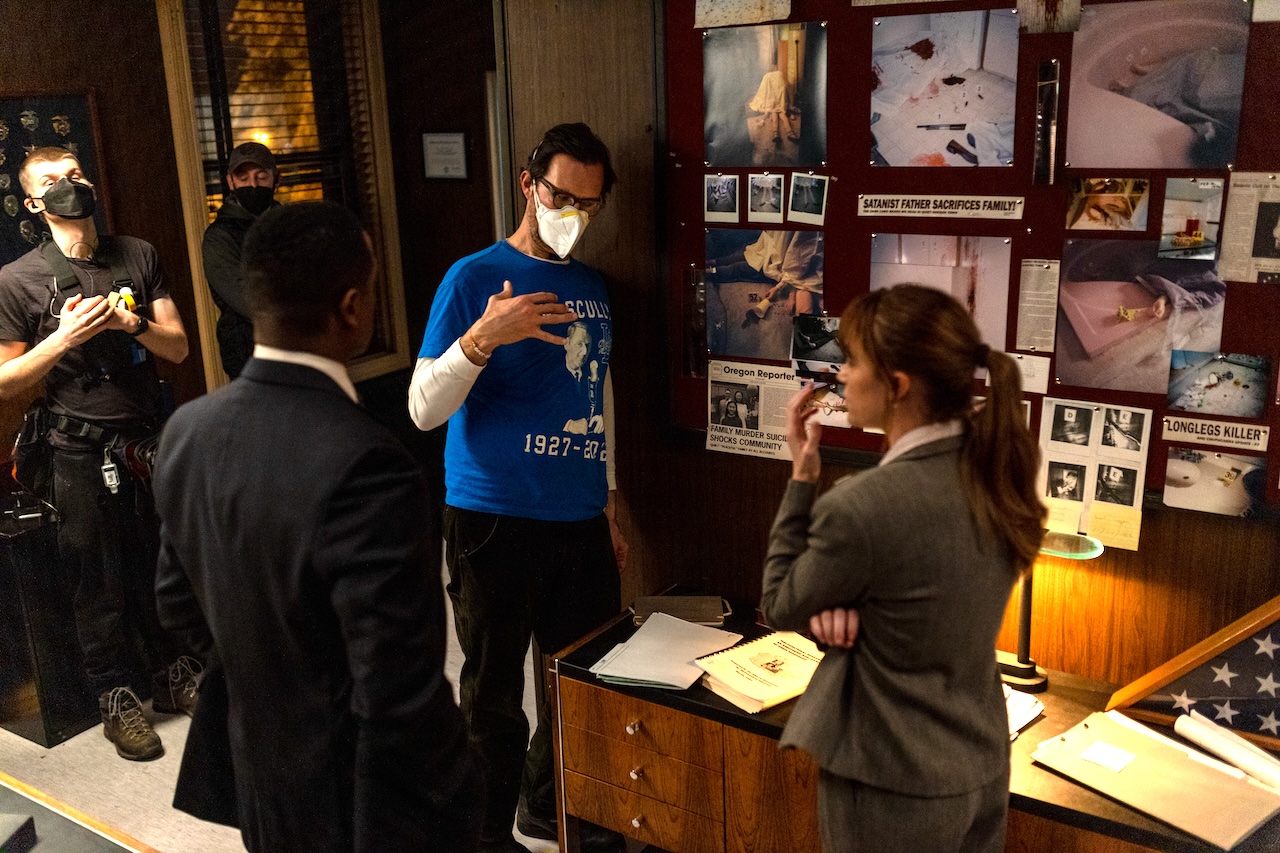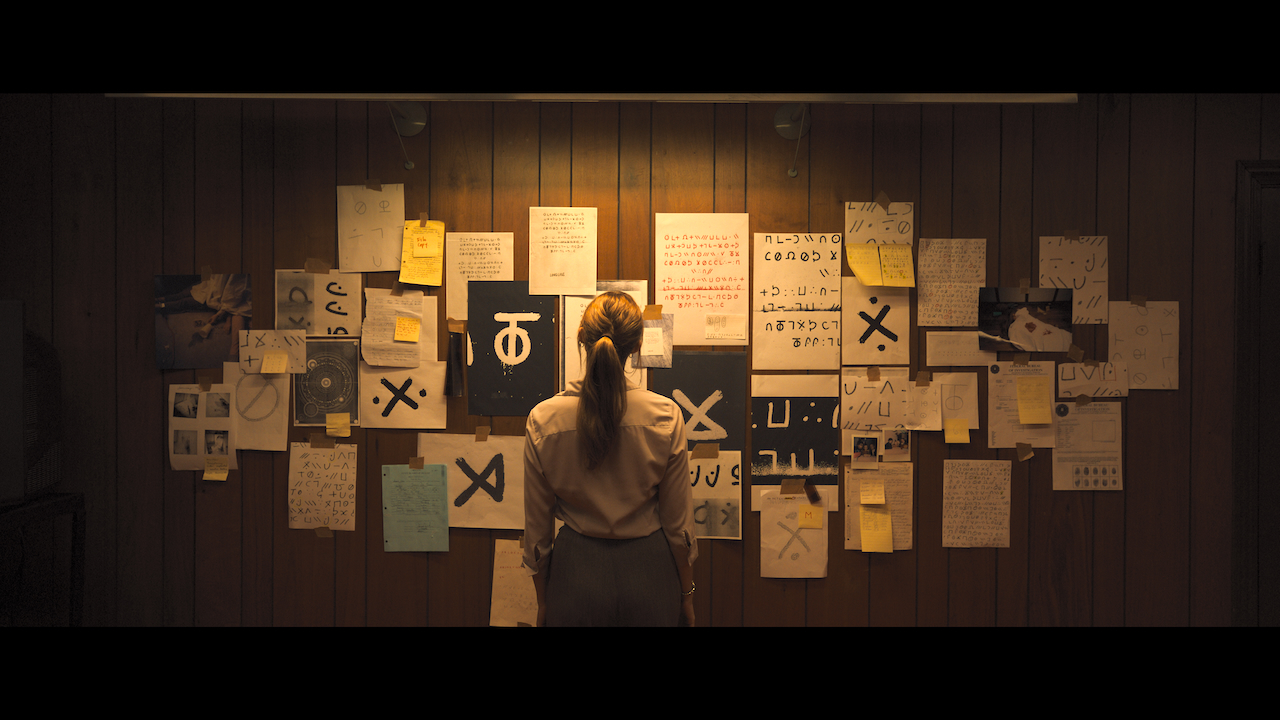“I always try to start with something that’s classical or feels like a pop interpretation of something that we have seen before,” notes filmmaker Osgood Perkins of Longlegs starring Nicolas Cage as Longlegs and Taika Monroe as Agent Harker.
Occult films rest on the familiar idea of the henchman/ woman that “does the dirty work for the Devil.” In this case, it’s a vertically-enhanced dollmaker who unleashes powerful demons that cause people to violent kill their families.
“You start with a regular person like Frankenstein’s Igor or Renfield. One day their life changes because they get a cold tap on the shoulder from the evil presence, whether it’s Dracula or the Devil. Their life is not theirs anymore.” There is no opting out even if they change their mind.
Perkins never over-thought Longlegs’ backstory. He lets the story lead without too much story baggage to weigh down the story.
He offers one possible insight into Longlegs’ pre-occult life. “Longlegs probably wanted to be a guitar player in a glam rock band called Longlegs. One day, the Devil started sounding through his headphones and through his records in the ‘Judas Priest’ sense.” The band never made it and an enticing offer arrives in the form of a tap on the shoulder making him an offer too good to refuse.
His face is garishly powdered, his hair long and unruly, and his face scarred from extensive plastic surgery in an attempt to impress the Devil. He is driven by “obsessive devotion.”
Nicolas Cage shares about his inspiration for his character. “I wanted Longlegs to be very androgynous. I was thinking about the prophet in Fellini’s Juliet of the Spirits, and the prophet was asking, ‘Do you think I’m beautiful?’ You told me to sort of plump my hair. So I did that, and then I started saying that to Maika.’” Longlegs had to be firmly grounded in his service to Satan while maintaining his outlandish facade.

Agent Carter (Blair Underwood), Osgood Perkins and Agent Harker (Maika Monroe) on set. Photo courtesy of Neon
The film invites the audience to ponder, wallow, and ruminate in the pervasive dread of its shadowy tone rather than dutifully skip from one scary story signpost to the next.
Longlegs radiates shades of Silence Of The Lambs in the form of Agent Harker desperately connecting pieces of a puzzle to solve the mystery of a killing spree. Again, Osgood Perkins isn’t overly-concerned with strictly following any screenwriting templates regarding how the story plays out. “The artist does the thing and sometimes it’s not so deliberate. You’re trying to make something you like.”
“It sounds like The Silence Of The Lambs, until it’s not. That is why I keep calling the movie a pop art piece. Remember all these things you love about horror movies? We’ve got all of them. We’ve got possessed dolls. We’ve got axe murderers. We’ve got the Devil. We’ve got FBI black jackets. We’ve got the serial killer that nobody can catch. We’ve got clues. We’ve got weird coded letters. We’ve got the Bible. We’ve got bloody nuns, We’ve got shotguns,” proclaims Perkins.
Longlegs is a select pop parade of like greatest hits of horror; a horror movie mixtape
Osgood Perkins starts with pleasing traditional horror audiences with pop art and hopes “it bleeds out to other people.”
Agent Harker and Longlegs share many similarities – both sense the dread of something being very wrong in a world that never fully embraces them. She is a “clairvoyant” of sorts, an agent with heightened powers of perception, but patchy problem-solving skills. He makes possessed porcelain dolls.
The Simpsons Influence
The iconic animated family TV series is an unlikely inspiration for Perkins. The Simpsons heavily shaped modern popular culture. Perkins found out there were many children forbidden to watch the show by their parents for some reason.
“I was thinking a lot about the Simpsons which were so formative for me. It was one of the first entities that commented on culture in a way you haven’t realized before.”
“Haven’t you ever realized that all fathers or do this weird pop thing; this knowing irony around tropes and archetypes? So, when I’m getting into a horror movie like Longlegs, I want to use the tropes and the generic imperatives, but I want them to be aware of themselves.”

The Simpson. Photo courtesy of FOX Networks
Perkins states Longlegs is a “weird amalgamation of a birthday clown and a rock and roll singer. He’s in the realm of Pennywise and Judas Priest. So, I’m trying to find these commonly-accepted touch stones, remixing them, commenting on them, and making choices about them that are a little bit off-center to make it all feel fresh again.”
Nicolas Cage fully embodied his role in Longlegs and appreciated Perkins’ vision. Cage told Perkins, “I want to say all the dialogue as you wrote it. That’s the best part.” Perkins continues, “Nic exists to be in service to the movie. Some iconic actors lead with their ego. He worships the silver screen, and so he really is out there to honor the gods of movie making. He fits himself into the movie. He stretches himself far and comes off as being energized and variable in his performances.”
Longlegs spends a good deal of screen time hidden, obscured, or distorted. We see the fragmented world through a looking glass as the film glides through the menacing mood and world of the story. In the third act, after Longlegs has left the movie, the narrative focuses on the story between Lee and her mom, Ruth (Alicia Witt) to explore its thematic underpinning.
“It’s the bedtime story (or story time as Perkins put it). It’s the parent devising an interpretation of the world for their child that they feel is protecting them from certain things that they don’t need them to know yet. It’s a fairy tale.” Longlegs blends the nightmarish fears of childhood in a tilted world, but they can’t fully decipher, with the anxieties of parenthood.
“It’s a bad world, and when Ruth finally comes out with her truth and tells the story, it makes me think about my own parents. That resonates as the most dynamic section of the movie; the revelation.” Parents spend decades promulgating a fabricated, palatable reality for their children, but neglect to appreciate the time it takes to reverse the inadvertent damage they’ve caused.
The ‘Osgood Perkins’ Writing Process
“If it’s gonna be a hundred page script, it’s gonna have a hundred page outline,” states Osgood. “A hundred pages of prose is everything I know; everything that’s texturally or thematically true and dialogue I want to hear.”
“Everything is written going to the screenplay pages is the last thing I do. I don’t write a lot of drafts. I probably write one main draft and then I may tinker with it.”
Writing a hundred page outline is how you find the subtext of the story
“During pre-production, I put my head together with one of my producers Dan Kagan, and we figured out all the breadcrumb stuff – the FBI stuff, all the triangles, the dates, and the MacGuffins to distract and engage the audience That took a little bit longer.”
In conclusion, Oz Perkins provides some counsel to screenwriters. “Many scripts are too literary and read like instruction manuals.”
“You’ll never find the words interior or exterior in my screenplays. They’re too antiseptic. I’ll just say, ‘Mom’s kitchen.‘” In that sense, Perkins prefers writing slug lines rather than scene headings. “We see something impactful that the camera might want to see. That is a way into the next movement of the movie. I also write characters thoughts.“
